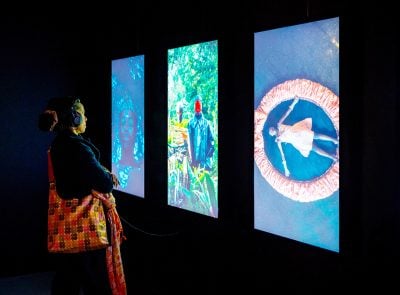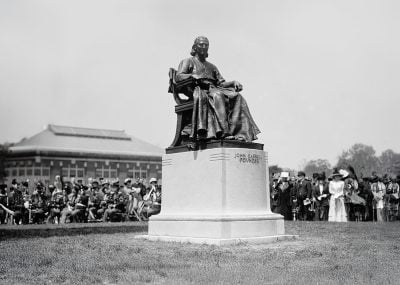Ablaye Ndiaye Thiossane has been described as “part of the very fabric of Senegalese national identity” yet, remarkably, this is his first album recorded and released as lead artist. Joined here by members of Orchestra Baobab, legendary Congolese guitarist Papa Noel and Africando’s Medoune Diallo, the eponymously titled CD, Thiossane, stands out as a rich addition to Senegal’s Afro-Cuban musical heritage.
Ablaye Thiossane is, furthermore, a world-renowned contemporary artist. The name ‘Thiossane’ actually means ‘ancestry’ and ‘tradition’ in Wolof, and appropriately suggests his life’s work. A multi-talented artist, he has gained recognition in many areas of the arts.
He was born in the village of Saam, near Thies, about 80km from Senegal’s capital Dakar, to a family of traditional musicians and storytellers. As a child, he grew up listening to the traditional tunes much loved by his mother and key in shaping a subsequent musical career.
But first, he studied at the Senegalese National School of Fine Arts in Dakar where he gained recognition as a sculptor. He then became an accomplished actor, but you can add to his achievements the success he has had as a painter and playwright as well as a noted singer-songwriter.
As a self-taught painter, Thiossane has worked in a number of different media, including tapestries, paintings, large wall murals and book illustrations. One of his best-known works is a tapestry commissioned for the Senegalese National Contemporary Art Exposition that toured Brazil, Mexico and North Africa from 1978 to 1981. His work has been exhibited in a dozen different countries.
A number of his paintings have also been interpreted in tapestries, with one being used as a design for a Senegalese postage stamp. Several others have been used as illustrations for books of traditional Wolof folktales. Themes appear and reappear in Thiossane’s visual work, but relate mainly to his very traditional background.
Pan-African fame
His music first achieved pan-African fame when his song ‘Talene Lampe Yi’ was selected as the radio theme for the Festival des Arts Nègres held in Dakar 1966. Now in his mid 70s, he has decided it is time to release his first album, although as lead singer for Orchestra Baobab he has been at the forefront of Afro-Cuban music in West Africa for many years.
The album is produced by Ibrahim Sylla with arrangements by François Bréant, famed for his ground-breaking work on, among others, Thionne Seck’s Orientissimo and Salif Keita’s Soro. Nine songs feature on this CD and reflect the languid, rhythmic and melodic Cuban-African dance music that still holds sway in Senegal, Mali and across West Africa.
Despite his age, Thiossane demonstrates that he still has a majestic voice and is clearly as relaxed on this recording as the instrumental accompaniment that his friends provide. The nine songs on the album include love songs, and a homage to the great king of Cayor (the region of Thies, his birthplace) who fought valiantly against colonialism and today represents one of the great heroes of Senegal’s independence struggle.
Other songs pay tribute to his family’s griot lineage; praise Senegal’s women; and he also chooses to sing a traditional song, about a billy goat, in a duet with Khar Mbaye Madiaga. A version of his song ‘Talene Lampe Yi’ is also included, the song that became the theme tune for Festival des Arts Nègres when Senegal hosted the first pan-African arts celebration and hosted artists such as Duke Ellington and Dizzy Gillespie of the US, Franco and Tabu Ley Rochereau from the Congo (then Zaire), and Odeneizer from Nigeria.
There is also a song about a girl who has lost her mother and suffers ill treatment at the hands of one of her father’s other wives, and ‘Bouki Ndiour’, which tells the tale of a hyena. The album rounds-off with another tribute, this time to Laye Mboup, the founder of Orchestra Baobab.
Want to continue reading? Subscribe today.
You've read all your free articles for this month! Subscribe now to enjoy full access to our content.
Digital Monthly
£8.00 / month
Receive full unlimited access to our articles, opinions, podcasts and more.
Digital Yearly
£70.00 / year
Our best value offer - save £26 and gain access to all of our digital content for an entire year!
 Sign in with Google
Sign in with Google 


